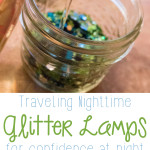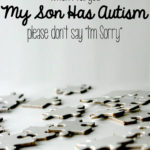This shop has been compensated by Collective Bias, Inc. and its advertiser. All opinions are mine alone. #RestEasySolutions #CollectiveBias
![When your child is very sensory seeking, you can stimulate their senses with this visual, textural board! Great for sensory-seeking Sensory Processing Disorder or Autism Spectrum Disorder. #RestEasySolutions [ad]](http://i.imgur.com/VhN72Gy.jpg)
When you have a sensory-seeking child, bedtime can be rough. Some of the things that help a sensory-seeker sleep seem so counter-intuitive as a parent! It has taken me so long to find some things that have set Zack, my son who has a sensory processing disorder, up for success in sleeping. From sensory tricks to GoodNites products, it’s taken trial and error to figure out what worked, and today, I want to share what’s worked for us to help you get your sensory-seeker to bed!
Allow some active time before sleep. As a child, my mom would let me go to my room a bit early to “wind down” before bed, and it seems that’s a concept that most people are familiar with– time spent reading a book, or having some quiet time before bedtime. But when it comes to a sensory seeking child, that is not always quite enough– in order to lull Zack to sleep, I give him some time to play a game called “Jump Bed,”– it takes the whole family getting involved sometimes to get him to get his energy out through jumping, rolling, and crawling across a large bed. Sensory seekers don’t necessarily wind down in the same way the rest of us do. Giving your sensory seeker a few minutes on a mini trampoline, a balance board, or another active type gross motor activity can help them to sleep!
Give them a soothing way to calm themselves. I’ve learned that a Sensory Board that I created has helped my son go to bed by giving him a few sensory things he enjoys right before bedtime– we’ve worked it into our night to help him get to sleep… and they’re SO easy to make!
![When your child is very sensory seeking, you can stimulate their senses with this visual, textural board! Great for sensory-seeking Sensory Processing Disorder or Autism Spectrum Disorder. #RestEasySolutions [ad]](http://i.imgur.com/GsNbTGr.jpg)
All you have to do is start with a board– any size will work, but you want it to be relatively manageable to fit on your child’s lap or beside them at bedtime. I used an old canvas we had laying around. Then, begin attaching sensory items that will help them soothe– different kids have different tactile needs, but one thing my son especially loves is these paint cards in his favorite rainbow colors. I simply picked up paint swatch cards and taped them to the board– just apply tape on one side of the card, flip it over, and apply more tape in the same place on the backside, so they can flip the card back and forth without it falling off easily! My son loves to run his hands along this and hear the “flap flap flap” noise it makes, plus he’s a big fan of singing his rainbow colors song that he knows while flipping through them.
![When your child is very sensory seeking, you can stimulate their senses with this visual, textural board! Great for sensory-seeking Sensory Processing Disorder or Autism Spectrum Disorder. #RestEasySolutions [ad]](http://i.imgur.com/wXy0Kaz.jpg)
Play with texture by adding in some different varieties you know your child likes to touch. My son likes super soft and fuzzy things, and also feeling kind of disoriented textures (like touching paths of pebbles and such), so I tried to add some soft fuzzy items and also a section that had birdseed! The birdseed was the perfect texture for him to run his hands across. Simply use hot glue or other strong glue to attach your seeds or fabric or other sensory touch items to the board.
![When your child is very sensory seeking, you can stimulate their senses with this visual, textural board! Great for sensory-seeking Sensory Processing Disorder or Autism Spectrum Disorder. #RestEasySolutions [ad]](http://i.imgur.com/Tg9oUQx.jpg)
I also played with sound by adding in these elements– crinkled up parchment paper is a fun way to add a bit of a crinkling noise as he runs his fingers along the soft surface (tape means you can replace it as it gets worn down and less crinkly!), and running his fingernail across stripes of hot glue makes an interesting sound, also.
![When your child is very sensory seeking, you can stimulate their senses with this visual, textural board! Great for sensory-seeking Sensory Processing Disorder or Autism Spectrum Disorder. #RestEasySolutions [ad]](http://i.imgur.com/kwL4Jtx.jpg)
Finally, I attached one of my favorite diluted oil blends that tends to be calming to the board in the form of drops on cotton balls. When he touches or rubs the cotton balls, the fragrance releases slightly, giving him a calming blend to help lull him. (Be sure the oils you use are child-safe and diluted, just to be sure).
![When your child is very sensory seeking, you can stimulate their senses with this visual, textural board! Great for sensory-seeking Sensory Processing Disorder or Autism Spectrum Disorder. #RestEasySolutions [ad]](http://i.imgur.com/cbLXsvt.jpg)
All-in-all, the board contains a lot of different ways to stimulate his sensory seeking ways… and it’s a really good compromise when it comes to our bedtime routine. I still like the idea of winding down with a book like I did in my childhood, but as a sensory seeker, he struggles to listen when I read him a book unless he has something to do with his hands. Giving him this board to interact with while I read has been a great compromise for us, allowing him to be playing with texture and sound while allowing me to read him stories.
Consider music for sleep. Zack is a very musical child, so it just makes sense that he falls to sleep best if he has sounds going. I allow him to use his tablet at bed time to stream music or a video that will give him some noise. Once he falls asleep, that noise is replaced with some white noise from a fan to help him stay asleep. While removing devices and limiting screen time works for many, for my sensory seeker, it just meant that any little noise or movement woke him. Having music or talking to focus on meant that instead of seeking out those sounds, he was focused on the sound near him to fall asleep.
Consider heat and weight at bedtime. Weighted blankets, sheets that have been warmed in the dryer, and heating pads can all help your sensory seeker feel a little more comfortable at bedtime. Before Zack sleeps, I massage his limbs with slight pressure to soothe him to sleep– he will ask for it specifically, saying “mommy, will you rub my legs?” A little pressure and warmth can go a long way to get your sensory seeking child to sleep!
Eliminate worry about bedwetting. Bedwetting is incredibly common in many kids (many… like 1 in 6 kids between 4-12 years old!), but according to my son’s doctor, it is especially common among those that are diagnosed with autism spectrum disorders, sensory disorders, and more. Sometimes my son is so focused on a specific texture or sound that he just completely forgets to go to the bathroom. Sometimes his inputs are just so fried at the end of the day that the signal of “Hey, I need to go to the bathroom!” just never gets through. While I still do what I can to make sure he prepares for bed by going to the bathroom before he gets into bed, but sometimes, he just has an accident. It happens, even when he’s awake, it can happen. That’s why at bedtime we rely on GoodNites to help us.
![When your child is very sensory seeking, you can stimulate their senses with this visual, textural board! Great for sensory-seeking Sensory Processing Disorder or Autism Spectrum Disorder. #RestEasySolutions [ad]](http://i.imgur.com/ob3fbwJ.jpg)
GoodNites Bedtime Pants are really great because they come in fun character options, and they’re perfect for keeping kids dry in any position they happen to sleep in (for mine, it’s literally all over the place). Because they’ve got 5 layer protection, they are sure to hold leaks in.
These are our go-to for nights when we’re traveling (we pack these on vacation for overnights!) because they’re disposable and wear just like undies do!
Whenever Zack decides to sleep in my bed, like after a nightmare, I usually just stick down a GoodNites Bed Mat– it secures into place with adhesive, soaks up as much liquid as the GoodNites bedtime pants, and has a waterproof backing so I’m not having to change the sheets, which is always nice!
However, hands-down our favorite GoodNites product to help out, and the one we use nightly, is the GoodNites TruFit underwear– this looks and feels like real underwear because it is real underwear! It just has a place inside where you can place a disposible GoodNites TruFit protection insert (which you get when you buy the underwear, but can also get in a refill pack!). Just dispose of the pad and wash the GoodNites TruFit underwear! It’s super-simple, and because it is real underwear, it helps with confidence, too.
![When your child is very sensory seeking, you can stimulate their senses with this visual, textural board! Great for sensory-seeking Sensory Processing Disorder or Autism Spectrum Disorder. #RestEasySolutions [ad]](http://i.imgur.com/hwfRJSN.jpg)
GoodNites products are easy to find, too– just head over to your local Walmart store for a full selection of products for boys and girls, near the training pants! When you shop at Walmart, you can even save $2.00 with this coupon, while supplies last! The coupon is available at certain times until supplies run out, so be sure to keep checking back if you don’t get it this time around!
What are your best tips for getting a sensory seeking child to bed? Let me know in the comments below, and don’t forget to visit the Walmart site if you’re looking for bedwetting products, or grab the coupon to save here!





Love the idea of a sensory board. Also the underwear is a great idea….It looks like normal underwear. I LOVE it. Then kids still learning wont be embarrassed.